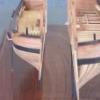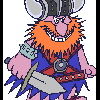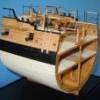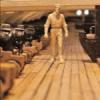
Roger Pellett
-
Posts
4,519 -
Joined
-
Last visited
Reputation Activity
-
 Roger Pellett got a reaction from mtaylor in Steamboats and other rivercraft - general discussion
Roger Pellett got a reaction from mtaylor in Steamboats and other rivercraft - general discussion
Several days ago there was a discussion on a build log regarding research for the steamer Chaperone and I questioned the absence of characteristic Ohio River yawl boats on a couple of well detailed models. It turned out that photographic evidence proved me wrong, but my question generated interest and a suggestion was made to move the discussion to this site, so here goes.
To me, most interesting thing about American Western Rivers steamboats was the way that innovators built these vessels to adapt to the then hostile environment that existed before the rivers were "tamed" with the current system of locks and dams. Conditions varied from very high water and swift currents to very shallow water. It was supposedly said that these boats could float on a heavy dew. In these low water conditions these boats using a system of heavy spars, tackles and their steam capstans could actually be lifted over sandbars.
Overcoming these navigational hazards also required a sturdy work boat to haul heavy hawsers ashore. Secured to large trees, these lines could warp the boats ahead. For this purpose, a specialized distinctive workboat called an Ohio River Yawl Boat was developed. Howard Chapelle described these boats in his American Small Sailing Craft. These boats were wide flat bottomed skiffs with considerable keel rocker and flaring top sides. This allowed the boat to carry heavy loads in very shallow water with ample stability.
Modellers wishing to include one of these boats on a steamboat model will find much information on the Internet. Googling Ohio River Yawl Boat will yield a number of interesting sites. First, there is a discussion on wooden boat.com, subheading Ohio/Mississippi River Skiff Yawl about these boats. Google books also has published Chapelle's small craft book. Both of these sources include Chapelle's drawings of representative craft. There is also an interesting article about Marietta, Ohio boatbuilder adapting this indigenous design to produce a inexpensive boat for high school age rowers.
Roger Pellett
-
 Roger Pellett got a reaction from Canute in Steamboats and other rivercraft - general discussion
Roger Pellett got a reaction from Canute in Steamboats and other rivercraft - general discussion
Several days ago there was a discussion on a build log regarding research for the steamer Chaperone and I questioned the absence of characteristic Ohio River yawl boats on a couple of well detailed models. It turned out that photographic evidence proved me wrong, but my question generated interest and a suggestion was made to move the discussion to this site, so here goes.
To me, most interesting thing about American Western Rivers steamboats was the way that innovators built these vessels to adapt to the then hostile environment that existed before the rivers were "tamed" with the current system of locks and dams. Conditions varied from very high water and swift currents to very shallow water. It was supposedly said that these boats could float on a heavy dew. In these low water conditions these boats using a system of heavy spars, tackles and their steam capstans could actually be lifted over sandbars.
Overcoming these navigational hazards also required a sturdy work boat to haul heavy hawsers ashore. Secured to large trees, these lines could warp the boats ahead. For this purpose, a specialized distinctive workboat called an Ohio River Yawl Boat was developed. Howard Chapelle described these boats in his American Small Sailing Craft. These boats were wide flat bottomed skiffs with considerable keel rocker and flaring top sides. This allowed the boat to carry heavy loads in very shallow water with ample stability.
Modellers wishing to include one of these boats on a steamboat model will find much information on the Internet. Googling Ohio River Yawl Boat will yield a number of interesting sites. First, there is a discussion on wooden boat.com, subheading Ohio/Mississippi River Skiff Yawl about these boats. Google books also has published Chapelle's small craft book. Both of these sources include Chapelle's drawings of representative craft. There is also an interesting article about Marietta, Ohio boatbuilder adapting this indigenous design to produce a inexpensive boat for high school age rowers.
Roger Pellett
-
 Roger Pellett got a reaction from Cathead in Steamboats and other rivercraft - general discussion
Roger Pellett got a reaction from Cathead in Steamboats and other rivercraft - general discussion
Several days ago there was a discussion on a build log regarding research for the steamer Chaperone and I questioned the absence of characteristic Ohio River yawl boats on a couple of well detailed models. It turned out that photographic evidence proved me wrong, but my question generated interest and a suggestion was made to move the discussion to this site, so here goes.
To me, most interesting thing about American Western Rivers steamboats was the way that innovators built these vessels to adapt to the then hostile environment that existed before the rivers were "tamed" with the current system of locks and dams. Conditions varied from very high water and swift currents to very shallow water. It was supposedly said that these boats could float on a heavy dew. In these low water conditions these boats using a system of heavy spars, tackles and their steam capstans could actually be lifted over sandbars.
Overcoming these navigational hazards also required a sturdy work boat to haul heavy hawsers ashore. Secured to large trees, these lines could warp the boats ahead. For this purpose, a specialized distinctive workboat called an Ohio River Yawl Boat was developed. Howard Chapelle described these boats in his American Small Sailing Craft. These boats were wide flat bottomed skiffs with considerable keel rocker and flaring top sides. This allowed the boat to carry heavy loads in very shallow water with ample stability.
Modellers wishing to include one of these boats on a steamboat model will find much information on the Internet. Googling Ohio River Yawl Boat will yield a number of interesting sites. First, there is a discussion on wooden boat.com, subheading Ohio/Mississippi River Skiff Yawl about these boats. Google books also has published Chapelle's small craft book. Both of these sources include Chapelle's drawings of representative craft. There is also an interesting article about Marietta, Ohio boatbuilder adapting this indigenous design to produce a inexpensive boat for high school age rowers.
Roger Pellett
-
 Roger Pellett got a reaction from dgbot in Chaperon 1894 by Mike Dowling - FINISHED - Model Shipways - Sternwheeler Steamer
Roger Pellett got a reaction from dgbot in Chaperon 1894 by Mike Dowling - FINISHED - Model Shipways - Sternwheeler Steamer
As long as we are critiquing this model kit, a discrepancy appears to be the use of generic round bottom ships boats.
Western Rivers steamships were outfitted with specialized flat bottom yawl boats. These boats had wide sterns and flaring topsides to allow heavy loads, particularly heavy mooring lines to be carried over the stern without capsizing. This is a distinctive feature of these vessels that the kit producers probably ignored in favor of stock fittings.
The Ohio River Museum in Marietta, Ohio has one of these boats on display, but that won't do you much good in Scotland. Drawings of these boats are included in American Small Sailing Craft, pages 98 and 99 by Howard Chapelle if you can find a copy and plans have been published in the Nautical Research Journal at least once. The Ohio River Museum has a website. They are also related to the Campus Martius museum also in Marietta and it might be easier to talk or email a live person there.
Roger Pellett
-
 Roger Pellett got a reaction from WackoWolf in Chaperon 1894 by Mike Dowling - FINISHED - Model Shipways - Sternwheeler Steamer
Roger Pellett got a reaction from WackoWolf in Chaperon 1894 by Mike Dowling - FINISHED - Model Shipways - Sternwheeler Steamer
Hi Kurt,
The boat in the first photo is not an Ohio River Yawl boat. It does look like some sort of round bottomed boat. The boats in the next two photos are typical Ohio River yawls- fairly wide and their top sides show considerable flair all the way back to the transom. I have no idea what the boat in the fourth photo is. It almost looks like a lumberman's bateau.
Alan Bates includes a brief description of these yawl boats in his Western Rivers Steamboat Cyclopedium.
I'll have to do some searching to find the information that I am looking for in the NRJ.
So it appears that Chaperon had a variety of boats during her life. That's not hard to believe.
Roger
-
 Roger Pellett got a reaction from mtaylor in Chaperon 1894 by Mike Dowling - FINISHED - Model Shipways - Sternwheeler Steamer
Roger Pellett got a reaction from mtaylor in Chaperon 1894 by Mike Dowling - FINISHED - Model Shipways - Sternwheeler Steamer
Hi Kurt,
The boat in the first photo is not an Ohio River Yawl boat. It does look like some sort of round bottomed boat. The boats in the next two photos are typical Ohio River yawls- fairly wide and their top sides show considerable flair all the way back to the transom. I have no idea what the boat in the fourth photo is. It almost looks like a lumberman's bateau.
Alan Bates includes a brief description of these yawl boats in his Western Rivers Steamboat Cyclopedium.
I'll have to do some searching to find the information that I am looking for in the NRJ.
So it appears that Chaperon had a variety of boats during her life. That's not hard to believe.
Roger
-
 Roger Pellett got a reaction from WackoWolf in Chaperon 1894 by Mike Dowling - FINISHED - Model Shipways - Sternwheeler Steamer
Roger Pellett got a reaction from WackoWolf in Chaperon 1894 by Mike Dowling - FINISHED - Model Shipways - Sternwheeler Steamer
As long as we are critiquing this model kit, a discrepancy appears to be the use of generic round bottom ships boats.
Western Rivers steamships were outfitted with specialized flat bottom yawl boats. These boats had wide sterns and flaring topsides to allow heavy loads, particularly heavy mooring lines to be carried over the stern without capsizing. This is a distinctive feature of these vessels that the kit producers probably ignored in favor of stock fittings.
The Ohio River Museum in Marietta, Ohio has one of these boats on display, but that won't do you much good in Scotland. Drawings of these boats are included in American Small Sailing Craft, pages 98 and 99 by Howard Chapelle if you can find a copy and plans have been published in the Nautical Research Journal at least once. The Ohio River Museum has a website. They are also related to the Campus Martius museum also in Marietta and it might be easier to talk or email a live person there.
Roger Pellett
-
 Roger Pellett got a reaction from mtaylor in Chaperon 1894 by Mike Dowling - FINISHED - Model Shipways - Sternwheeler Steamer
Roger Pellett got a reaction from mtaylor in Chaperon 1894 by Mike Dowling - FINISHED - Model Shipways - Sternwheeler Steamer
As long as we are critiquing this model kit, a discrepancy appears to be the use of generic round bottom ships boats.
Western Rivers steamships were outfitted with specialized flat bottom yawl boats. These boats had wide sterns and flaring topsides to allow heavy loads, particularly heavy mooring lines to be carried over the stern without capsizing. This is a distinctive feature of these vessels that the kit producers probably ignored in favor of stock fittings.
The Ohio River Museum in Marietta, Ohio has one of these boats on display, but that won't do you much good in Scotland. Drawings of these boats are included in American Small Sailing Craft, pages 98 and 99 by Howard Chapelle if you can find a copy and plans have been published in the Nautical Research Journal at least once. The Ohio River Museum has a website. They are also related to the Campus Martius museum also in Marietta and it might be easier to talk or email a live person there.
Roger Pellett
-
 Roger Pellett got a reaction from Cathead in Chaperon 1894 by Mike Dowling - FINISHED - Model Shipways - Sternwheeler Steamer
Roger Pellett got a reaction from Cathead in Chaperon 1894 by Mike Dowling - FINISHED - Model Shipways - Sternwheeler Steamer
As long as we are critiquing this model kit, a discrepancy appears to be the use of generic round bottom ships boats.
Western Rivers steamships were outfitted with specialized flat bottom yawl boats. These boats had wide sterns and flaring topsides to allow heavy loads, particularly heavy mooring lines to be carried over the stern without capsizing. This is a distinctive feature of these vessels that the kit producers probably ignored in favor of stock fittings.
The Ohio River Museum in Marietta, Ohio has one of these boats on display, but that won't do you much good in Scotland. Drawings of these boats are included in American Small Sailing Craft, pages 98 and 99 by Howard Chapelle if you can find a copy and plans have been published in the Nautical Research Journal at least once. The Ohio River Museum has a website. They are also related to the Campus Martius museum also in Marietta and it might be easier to talk or email a live person there.
Roger Pellett
-
 Roger Pellett reacted to Cathead in 18th Century Longboat by Cathead - FINISHED - Model Shipways - 1:48
Roger Pellett reacted to Cathead in 18th Century Longboat by Cathead - FINISHED - Model Shipways - 1:48
The longboat is finished! Work really slowed down as summer kicked in, and I struggled some with getting the standing rigging right, but it's done. I'm not happy with the quality of the deadeyes supplied in the kit; the holes are drilled in really uneven patterns, but I chose the best ones and made do. I had difficulty getting the tiny ironwork right, too, as you can likely see in the photo below, but like the rest of the model, it passes the "more than a foot away" test. Especially since the only folks who will likely ever see it will know less about sailing than I do!
I made four oars, but left out the anchor and windlass handles, because I decided I wanted the hull to look cleaner and less cluttered. The sails add a lot of life to the model, and I decided that was enough. I built a simple base, mounting the boat on thin wire inserted into holes drilled into the keel and base. This allowed me to bend the wire slightly, heeling the boat over onto her port side a bit, as she would be with the sails set this way. I think it adds some life to the display. Here's a photo gallery of the completed longboat.
I'm pretty pleased with the overall outcome. It wouldn't win any awards at a show, for sure, but it's pleasing to the eye. The sails and the new color scheme make it feel unique, and gave me a feeling of ownership over a very common kit.
Many thanks to all of you who followed along, offered advice and encouragement, and politely overlooked my shortcomings. And thanks to Chuck for such an interesting little kit.
-
 Roger Pellett got a reaction from mtaylor in Great Republic 1853 by rwiederrich - FINISHED - four masted extreme clipper
Roger Pellett got a reaction from mtaylor in Great Republic 1853 by rwiederrich - FINISHED - four masted extreme clipper
Nice job planking the hull! Did you have to steam planks to fit the bilge radius?
Roger
-
 Roger Pellett got a reaction from tkay11 in Attaching a Cutter's foresail to its horse rail
Roger Pellett got a reaction from tkay11 in Attaching a Cutter's foresail to its horse rail
My model is based on the Admiralty drawing of a 32ft longboat reproduced on page 90 of The Boats of Men of War by W.E. May. In addition to a body plan, this drawing includes a sail plan, spar plan, and a number of rigging details. Unfortunately, it does not show the sheets for either of the headsails. The boat is what we would now call cutter rigged. It has a foresail hanked to the fore stay and a jib set flying from an unstayed bowsprit. The entire bowsprit appears rather flimsy and my interpretation is that the jib was principally intended for sailing off the wind and upwind in light air.
Your picture would indicate that you are a sailor so you know that for upwind sailing the foresail on this boat would be a workhorse and its sheet would be under considerable tension. While the jib sheet could be simply led through a block hooked to a convenient spot, the fore sail would require something more substantial.
If you go to the National Maritime Museum website Collections.rmg.co.uk and find the online listing for drawings and search for "longboat" item 17 is a drawing titled 31ft Longboat Circa 1801. Although this is not the same boat that I am modeling, it is roughly the same size and is fitted with a fore sheet horse.
I am aware that not all longboats were built to be carried aboard warships. Some were yard craft and a number of these are also shown on this same plan listing, so it may be that this particular longboat was intended as a yard craft. As a minimum in heavy air this foresail would at least need a pair of tackles each secured to an eyebolt but barring some new undiscovered information we can only speculate.
Thanks for your comment.
Roger
-
 Roger Pellett got a reaction from mtaylor in Attaching a Cutter's foresail to its horse rail
Roger Pellett got a reaction from mtaylor in Attaching a Cutter's foresail to its horse rail
My model is based on the Admiralty drawing of a 32ft longboat reproduced on page 90 of The Boats of Men of War by W.E. May. In addition to a body plan, this drawing includes a sail plan, spar plan, and a number of rigging details. Unfortunately, it does not show the sheets for either of the headsails. The boat is what we would now call cutter rigged. It has a foresail hanked to the fore stay and a jib set flying from an unstayed bowsprit. The entire bowsprit appears rather flimsy and my interpretation is that the jib was principally intended for sailing off the wind and upwind in light air.
Your picture would indicate that you are a sailor so you know that for upwind sailing the foresail on this boat would be a workhorse and its sheet would be under considerable tension. While the jib sheet could be simply led through a block hooked to a convenient spot, the fore sail would require something more substantial.
If you go to the National Maritime Museum website Collections.rmg.co.uk and find the online listing for drawings and search for "longboat" item 17 is a drawing titled 31ft Longboat Circa 1801. Although this is not the same boat that I am modeling, it is roughly the same size and is fitted with a fore sheet horse.
I am aware that not all longboats were built to be carried aboard warships. Some were yard craft and a number of these are also shown on this same plan listing, so it may be that this particular longboat was intended as a yard craft. As a minimum in heavy air this foresail would at least need a pair of tackles each secured to an eyebolt but barring some new undiscovered information we can only speculate.
Thanks for your comment.
Roger
-
 Roger Pellett got a reaction from Jack12477 in Greenwich Hospital barge of 1832 by druxey - FINISHED - 1:48 scale
Roger Pellett got a reaction from Jack12477 in Greenwich Hospital barge of 1832 by druxey - FINISHED - 1:48 scale
Can you tell us who is going to put blush the book?
Roger
-
 Roger Pellett got a reaction from Canute in Greenwich Hospital barge of 1832 by druxey - FINISHED - 1:48 scale
Roger Pellett got a reaction from Canute in Greenwich Hospital barge of 1832 by druxey - FINISHED - 1:48 scale
Can you tell us who is going to put blush the book?
Roger
-
 Roger Pellett got a reaction from tkay11 in Attaching a Cutter's foresail to its horse rail
Roger Pellett got a reaction from tkay11 in Attaching a Cutter's foresail to its horse rail
Tony,
I agree, the rigging of the main sheet for your cutter is exactly as described in Steel.
What I have been trying to figure out is the system used on a much smaller vessel, a 32 ft longboat.
Roger
-
 Roger Pellett got a reaction from mtaylor in Greenwich Hospital barge of 1832 by druxey - FINISHED - 1:48 scale
Roger Pellett got a reaction from mtaylor in Greenwich Hospital barge of 1832 by druxey - FINISHED - 1:48 scale
Can you tell us who is going to put blush the book?
Roger
-
 Roger Pellett got a reaction from mtaylor in Attaching a Cutter's foresail to its horse rail
Roger Pellett got a reaction from mtaylor in Attaching a Cutter's foresail to its horse rail
Tony,
I agree, the rigging of the main sheet for your cutter is exactly as described in Steel.
What I have been trying to figure out is the system used on a much smaller vessel, a 32 ft longboat.
Roger
-
 Roger Pellett got a reaction from mattsayers148 in 18th Century Longboat by Cathead - FINISHED - Model Shipways - 1:48
Roger Pellett got a reaction from mattsayers148 in 18th Century Longboat by Cathead - FINISHED - Model Shipways - 1:48
To me, the question is what you are trying to achieve, appearance of an actual boat, a modeling convention, or artistic license.
I am building a 1:32 scale longboat of the same era. My idea is to show the boat moored with sales furled as shown in a 1717 view of the city of Nre York. This calls for realism. For a number of reasons I think that the bottoms of these were often treated with tar resulting in a very dark brown bottom not white. Top sides would be treated with resin resulting in a tan finish. Planking seams would be quite prominent beacaus they were payed with tar. The insides were often painted "sad" color, a mud color. Color would be used sparingly- an earth pigment color for the sheer strake. The transom could be painted with an earth pigment color or the sad color.
Roger
-
 Roger Pellett got a reaction from tkay11 in Attaching a Cutter's foresail to its horse rail
Roger Pellett got a reaction from tkay11 in Attaching a Cutter's foresail to its horse rail
I just noticed this post. I have been pondering this subject while working on my Royal Navy longboat model as some Admiralty drawings show a horse for the foresail. My problem with knotting the tail of the sheet to itself would be trying to untie it under tension especially when wet- a necessary thing to be able to do with any sheet in a boat under sail. Steel mentions one other idea that I like better. The block on the horse is provided with an over length sheave pin on hat serves as a belaying pin for the tail of the sheet.
Roger Pellett
-
 Roger Pellett got a reaction from mtaylor in Attaching a Cutter's foresail to its horse rail
Roger Pellett got a reaction from mtaylor in Attaching a Cutter's foresail to its horse rail
I just noticed this post. I have been pondering this subject while working on my Royal Navy longboat model as some Admiralty drawings show a horse for the foresail. My problem with knotting the tail of the sheet to itself would be trying to untie it under tension especially when wet- a necessary thing to be able to do with any sheet in a boat under sail. Steel mentions one other idea that I like better. The block on the horse is provided with an over length sheave pin on hat serves as a belaying pin for the tail of the sheet.
Roger Pellett
-
 Roger Pellett got a reaction from dvm27 in Steamboats and other rivercraft - general discussion
Roger Pellett got a reaction from dvm27 in Steamboats and other rivercraft - general discussion
A number of years ago the late model builder William F. Wiseman built a model of the very small river boat Myrtle Corey. He built the model entirely from photographs using geometric projection techniques. The NRG has downloadable copies describing his techniques that can be bought for a few dollars. Look up his name on their website. Mystic Seaport bought his model collection from his estate and those of us that attended last fall's NRG conference got to see them. The photo's in the Journal do not do them justice. I remember seeing his spectacular Far West model but not Myrtle Corey.
Roger Pellett
-

-
 Roger Pellett got a reaction from dafi in up and down anchor lifting
Roger Pellett got a reaction from dafi in up and down anchor lifting
With regard to dafi's post above two opposite forces act on a submerged object. Gravity equal to the open air weight of the object is pulling it down. Buoyancy equal to the weight of the the water displaced by the object is pushing up. The force on the anchor cable is therefore equal to the net of these two forces.
If water is one seventh as dense as wrought iron, then the force on the anchor cable after being broken out is 6/7 not 1/7 of the anchor's weight.
Roger Pellett
-
 Roger Pellett got a reaction from Gerhardvienna in Steamboats and other rivercraft - general discussion
Roger Pellett got a reaction from Gerhardvienna in Steamboats and other rivercraft - general discussion
A number of years ago the late model builder William F. Wiseman built a model of the very small river boat Myrtle Corey. He built the model entirely from photographs using geometric projection techniques. The NRG has downloadable copies describing his techniques that can be bought for a few dollars. Look up his name on their website. Mystic Seaport bought his model collection from his estate and those of us that attended last fall's NRG conference got to see them. The photo's in the Journal do not do them justice. I remember seeing his spectacular Far West model but not Myrtle Corey.
Roger Pellett











